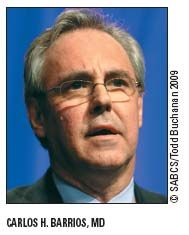TKI inhibitors turn in mixed results in breast cancer
Multi-targeted TKI inhibitors are gaining traction in the treatment of advanced breast cancer, although results from four different trials do show varying degrees of efficacy.
SAN ANTONIO-Multi-targeted TKI inhibitors are gaining traction in the treatment of advanced breast cancer, although results from four different trials do show varying degrees of efficacy. In multiple presentations at SABCS 2009, researchers made their respective cases for adding sorafenib (Nexavar), motesanib (MONET1), and sunitinib (Sutent) into the treatment mix.
With the exception of one agent, the overall results were promising, but oncologists need to bear in mind that although these similar drugs have broad activity, the jury is still out on how to administer them optimally.
Sorafenib: TIES and SOLTI
Early results were presented for sorafenib in combination with either capecitabine (Xeloda) or paclitaxel from a collaborative group-sponsored randomized double-blind phase IIb trials program called TIES (Trials to Investigate the Efficacy of Sorafenib in Breast Cancer), which is evaluating the TKI in patients with advanced HER2-negative breast cancer.
Jose Baselga, MD, chair of medical oncology at Vall d'Hebron University Hospital in Barcelona, Spain, offered updated results from the SOLTI-0701 trial (see page 22), reporting that sorafenib plus capecitabine continued to show favorable results over capecitabine alone (see Table on page 3).
An exploratory subgroup analysis found consistent benefit for the combination regardless of disease-free interval, number of metastatic sites, and country of treatment. “The subgroup analyses confirm the robustness of the progression-free survival [PFS] benefit. Sorafenib plus capecitabine was favored across all pre-specified and exploratory subgroup analyses,” Dr. Baselga said (abstract 45).
While hand-foot skin reactions were common in the study with sorafenib, Dr. Baselga said, “we are working on ways to reduce this with careful monitoring. We are confident we can improve this by being on top of it from the beginning.”
Based on the results of the TIES study, William S. Gradishar, MD, professor of medicine at Northwestern University School of Medicine in Chicago, reported “a signal of potential activity” with sorafenib used in combination with paclitaxel compared with paclitaxel alone (abstract 44).
The study randomized 237 patients from the U.S., India, and Brazil to paclitaxel (90 mg/m2 weekly) plus sorafenib (400 mg/m2 orally bid) or to paclitaxel plus placebo.
Median PFS, the primary endpoint, was 6.9 months with the combination and 5.6 months with single-agent paclitaxel, for a 21% relative reduction in risk of death or progression (P = .0857). Dr. Gradishar called this “a favorable trend,” and said that the P value could have been greater had there not been excess deaths in the sorafenib arm (17 of 20) related to conditions such as malaria and tuberculosis in the large Indian cohort (n = 170).
“We think these deaths skewed the PFS. Time to progression [TTP], which does not include deaths, showed a three-month spread that looks more impressive,” Dr. Gradishar said. TTP was reduced by 33% with the combination (see A second opinion).
The median response duration was 5.6 months with sorafenib/paclitaxel and 3.7 months in the control arm (P = .0079) while objective response rates were 67% and 54%, respectively (P = .0234). No unexpected toxicities were observed, although about 30% of patients who received sorafenib developed serious hand-foot skin reactions.
Improved PFS with motesanib
First-line treatment with motesanib plus paclitaxel turned in results that were comparable to treatment with bevacizumab (Avastin) plus paclitaxel. However, gallbladder toxicity was of concern with the motesanib cocktail.
CIRG/TORI 010 was the first randomized trial to compare a small-molecule VEGF-TKI with bevacizumab. The 10-month analysis of the phase II trial in HER2-negative metastatic breast cancer was presented by John Mackey, MD, from the University of Alberta in Edmonton. Sara Hurvitz, MD, from the University of California, Los Angeles, was a co-author.
The study randomized 282 patients to paclitaxel (90 mg/m2 weekly for three of four weeks) or to paclitaxel plus motesanib (125 mg/m2 orally daily) or bevacizumab (10 mg/kg at week one and week three; open label). Patients in the single-agent paclitaxel arm could cross over to motesanib on progression of disease (abstract 47).
Responses were observed in 41.49% of the paclitaxel arm, 49.45% of the motesanib/paclitaxel arm, and 51.55% of the bevacizumab/paclitaxel arm. PFS for the intention-to-treat (ITT) population was nine months for the paclitaxel arm, 9.49 months for the motesanib/paclitaxel arm, and 11.5 months for the bevacizumab/paclitaxel arm, Dr. Mackey reported.
“The efficacy of motesanib/paclitaxel was comparable to bevacizumab/paclitaxel. It achieved an improvement in PFS and response rate over the control arm, which actually performed better in this study than in the [bevacizumab-based] ECOG 2100 trial,” Dr. Mackey said.
But motesanib was not without its faults, specifically gallbladder toxicity. Any grade cholecystitis and/or gallbladder enlargement was reported in 8.7% of patients treated with motesanib vs fewer than 1% of patients who did not receive motesanib in the CIRG/TORI 010 trial. Grade 3-5 hepatobiliary disorders were observed in 8 of 92 patients who received motesanib vs 3 of 89 who received placebo and 0 of 96 who received bevacizumab. Four patients underwent surgery for gallbladder disease and then went back on the motesanib regimen. Grade 3-4 gastrointestinal toxicity and neutropenia were also more common in the motesanib arm.

No benefit with single-agent sunitinib
The global Pfizer-1107 study looked at sunitinib as a single agent in 482 patients with HER2-negative advanced breast cancer.
The study compared sunitinib (37.5 mg/d) with capecitabine (1,000 to 1,250 mg/m2 bid on days 1 to 14 every three weeks).

According to the results, median PFS was 2.8 months with sunitinib and 4.2 months with capecitabine, for a statistically significant difference favoring capecitabine (P = .002), reported Carlos H. Barrios, MD, of Pontificia Universidade Catolica do Rio Grande do Sul in Porto Alegre, Brazil.
The objective response rate was 11.3% with sunitinib and 16.4% with capecita-
bine while the clinical benefit rate was 19.3% vs 27% (P = .05).
The median duration of response was 6.9 months vs 9.3 months. Serious adverse events were reported by 30% and 17%, respectively (abstract 46).
“The independent Data Safety and Monitoring Committee, therefore, recommended that study enrollment be discontinued because of the futility of reaching the primary endpoint,” Dr. Barrios said.
Vanatage Point
TKI stories at SABCS advance drugs to phase III trials

TKIs may have a role in breast cancer if the best means of giving them can be determined, said Clifford Hudis, MD, chief of the Breast Cancer Medicine Service at Memorial Sloan-Kettering Cancer Center in New York.
Overall, Dr. Hudis' take on the SABCS presentations was positive. He noted that drugs may be from the same class and have broad activity, but they “are not the same drugs at all” and perform differently in trials.
“We heard three different stories in San Antonio,” he said. “We heard a drug development story that showed if we add sorafenib to standard chemotherapy we get a signal of benefi t; a clear signal in the SOLTI trial and one that is less clear in the second TIES trial presented by Dr. Gradishar. However, each of the TIES studies is small and, therefore, statistically the fi ndings are consistent with a sorafenib benefi t. The point of these TIES trials was to decide whether to conduct a phase III trial, and this will now be done.
Dr. Hudis is also a TIES investigator and is heading up a trial comparing sorafenib with gemcitabine (Gemzar) or capecitabine (Xeloda) after progression occurs with bevacizumab (Avastin). The TIES program includes studies that are large enough to support proof of concept, but small enough to be practical as phase IIb studies. “Clinicians interested in sorafenib can have access to it through these studies,” he said.
The second story showed that motesanib “is very active and can be considered parallel with bevacizumab,” Dr. Hudis said. But the study also revealed a hepatobiliary toxicity profi le with this drug, which is a concern, although that should not dampen interest in the drug. “Motesanib is a pan- VEGF inhibitor, and perhaps we need to tweak its targeting,” he said. “I don’t see this as negative but as consistent with the hypothesis that TKIs may have a role if we can get the approach right.”
As for the third story with sunitinib, the trial took on “a very steep challenge. Sunitinib was evaluated as a single agent, which most people would predict would not be active. But it was brave to do the trial, and we learned that we would need to pair the drug with chemotherapy,” he said.
Newsletter
Stay up to date on recent advances in the multidisciplinary approach to cancer.